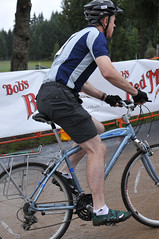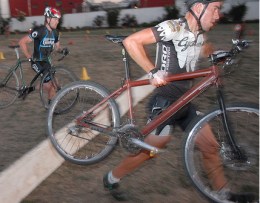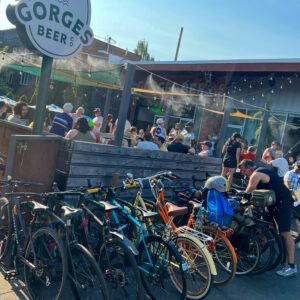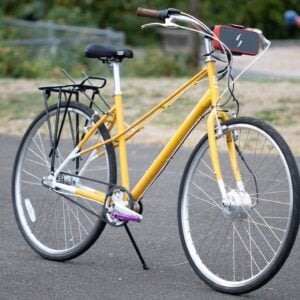
nearly any bike; but these
tips will help your conversion
work better.
(Photos © J. Maus)
As fall approaches it’s time to start dreaming of the thrill of mud, cowbells, Belgium fries and waffles and hundreds of people cheering for you as you ride your way through cyclocross season.
Whether you’re toying with testing the race field for the first time, or you’re heading back as a dedicated mud junkie, this is a simple guide to get — and keep — you rolling.
First, a little ‘cross background for the uninitiated. Cyclocross is a style of bike racing on a 1-2 mile dirt/gravel/mud/sand/snow/ice/pavement course for about 45 minutes. Part of the race is dismounting your bike and hopping over foot-high barriers, lifting your bike over them and re-mounting your bike as smoothly as possible. (Think of when you were a kid racing your friends around the block, make it partially off-road and add a small obstacle course and you’re in the ballpark. Oh. And there are usually lots of spectators the whole way around the course clapping, yelling and ringing cowbells to cheer you on.)
Choosing Your Weapon
Note: No matter which bike you pick, make sure it has fresh brake pads and is tuned for racing before you go. If you raced on it repeatedly last season, it will most likely need all new cables and possibly a few new bearings. Tune-up before you throw down!
Cross Bike — A cyclocross bike is a type of road bike with some frame modifications. It has regular road drop bars and 700c road sized wheels, but with a wider (32+mm), knobby tire for better traction. There is more space between the wheels and frame, and brakes are usually cantilever or disc—all for plenty of clearance for shedding mud and grass. The bottom bracket (where the cranks go into the frame) is positioned higher to make it easier to get over barriers and turn in tight corners. The gearing is also set up lower—or easier to pedal—than traditional road bikes. There are no water bottle cages as they would interfere with carrying your bike (besides, you really won’t have time to drink).
Pros: It’s a bicycle well designed for the job and you can use it in the off-season for cycle touring or commuting since they easily can fit fenders. It’s also much lighter than other options.
Cons: A bike like this can be cost prohibitive. Not always the best choice if you’re just dabbling and not sure ‘cross is the event for you.
—
Touring Bike — If you already have a bike that is made for touring, it has both clearance and cantilever brakes. Touring bikes are generally heavier, have more gears and lower bottom brackets than cross bikes. To convert a touring bike to a cross bike, just install a set of cyclocross tires and remove any seat bags, racks, water bottle cages or frame pumps.
Pros: Very similar to a cross bike. I raced my first two seasons on one and had a blast. It’s the next best choice to a cross bike since it has a road wheel size and is inexpensive to convert.
Cons: Not as light as a cross bike and doesn’t steer as well.
—

Mountain Bike — Mountain bikes can be easily converted to work well for cyclocross. While any kind of bike is allowed to race, bikes with suspension have a lot of extra weight (which slows you down) and the courses are not rough enough to justify needing it. If you don’t have rear suspension you can change out your fork and make your bike fully rigid, which will make it lighter. It’s also fairly easy to find an old, fully rigid bike used. The rules state that you can’t have bar ends, so remove those if you have them. To convert for cross, install some narrower tires (1.25” are the best) with lower profile knobs than you’d normally want for mountain biking.
Pros: If you already have an off-road bike, it’s inexpensive and easy to convert. If you don’t, it not hard to find a cheap one or borrow a friend’s and buy some new tires for it. Plus you’ll be building your bike handling skills and fitness for next season. It’s a wonderful choice for the beginner.
Cons: It’s a bit heavier (ie-slower) and harder to carry over the barriers — but the “pro” of that is you’ll generally get more cheers for working harder!
—
Road Bike — It’s possible to race a road bike on a cyclocross course, but only if the course is completely dry and lacking any sand or gravel. Even then you’ll be compromising traction since traditional road bikes don’t have room in the frame or brakes for bigger, knobby tires that can absorb the bumps and help you stay upright in corners. There is no room on a traditional road bike for mud to clear out, so if there’s even one puddle, your wheels may come to a halt before the race is over.
Pros: You may already have one and the other options don’t seem feasible.
Cons: There aren’t many races in Oregon that don’t have mud, sand or gravel. You may be wasting your money if you can’t finish a race because your bike is clogged with mud or you keep slipping (or worse yet, fall) in the sand or gravel.
—
Bonus Quick Tips for After Your Race
Cyclocross is super fun — but very hard on your frame, bearings and components. Here are some quick tips for after your race:
- Clean your bike as soon as you can after every race. A bucket of soapy dish water, a big sea sponge and a very light spray of hose can go a long way.
- Lubricate your chain and pivot points of your derailleurs after every cleaning.
- If you wash your bike with a hose, let it sit upright and drain out before you hang it by the front wheel.
- Though it maybe tempting, never use a pressure washer or high-pressure garden hose to clean your bike. It only forces water and dirt into the most expensive parts of your bike—the bearings—and will add to your maintenance expense later down the road.
— Stay tuned for more cyclocross how-to articles from Tori Bortman. Read her past BikePortland articles here.







Thanks for reading.
BikePortland has served this community with independent community journalism since 2005. We rely on subscriptions from readers like you to survive. Your financial support is vital in keeping this valuable resource alive and well.
Please subscribe today to strengthen and expand our work.
Excellent! Thanks, Tori! bikeportland.org needs more articles like these.
For a touring or a road bike with a low bottom bracket, I would also suggest putting on a shorter set of cranks, that will give you more clearance and allow you to spin better, for quicker acceleration. For example, if your existing cranks are 175 mm, try replacing them with 165 mm cranks. It will feel different at first but you will get used to it.
Burr: That’s a great suggestion, but we hoped to keep this article simple for the beginner. Switching out cranks can sometimes be more of a time/money commitment than most new folks want.
Still, this is a great suggestion for people who convert their bike every season. Thanks!
I would note that older general purpose road bikes like late 70s and early 80s Schwinn Travelers and Le Tours, many Peugeots, even Treks had more tire clearance than racing oriented road bikes from the early 90s on up. Many of these old frames can clear 1.25″ 27″ tires or 32mm with 700c although the brakes won’t leave the mud clearance that cantilevers do.
Build 26 inch wheels with cross tires–drum brake on the front–for your track/street fixie.
Super torquey and super agile. Drum brake is immune to water and crud.
Another great post, Tori! Thanks!
Thanks for the post, Tori.
I’d be interested in a “guide to spectators” — how to ride to Alpenrose, where to get cowbells, what kinds of refreshments are available, etc.
Ted Buehler
It’s coming soon! Look for another article in the next week for a “how to get started” guide to CX.
Thanks for the great suggestion!
Ted,
We’ll have plenty of cowbells for sale at the race. Cross Crusade Gear will have a booth at each race with bells for $5. Plus shirts, socks, hats etc.
Best place to watch at Alpenrose is probably the run up on the back side of the velodrome.
There will be free Stumptown coffee provided by Chris King and free Bob’s Red Mill oatmeal. Jake the Frites guy will be serving up fries all day and there will be a number of food carts too.
Brad Ross
Director, Cross Crusade Cyclocross Series.
Are there any advantages or disadvantages going with a single speed CC bike? Way more accessible on price and seem easier to maintain, but will you get left in the dirt riding against bikes with gears? Are single speeds allowed in all races?
Single speeds are allowed in the races. Your thoughts that they are more inexpensive and easier to take care of are right on the money.
However, most single speeders (SS) have to have multiple rear freewheels with different numbers of teeth and bikes that have the ability to adjust chain length (or different chains) depending on what the course looks like. For example, you’d want a higher gear for a flat course, a lower or mid-low for a hillier course.
There are plenty of discussions on forums if you want to try SS out, and it’s definitely a great way to test the waters without spending too much money.
Thanks for the comment, it’s a great option for folks to consider.